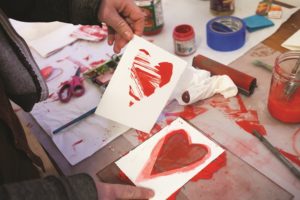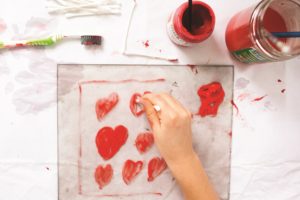During a recent snowstorm, I made monoprint cards with my kids. It proved to be a fun, though messy, way to pass the time when the electricity went out. The collaborative nature of our session allowed for a lot of creative cross-pollination.

I encourage you to find a few others and throw a card-making party. It might be just what you need to lift your spirits during this cold winter. And, if you’re like me and never got around to sending out holiday cards, here’s a chance to redeem yourself — make your monoprints into valentines.
What Is a Monoprint?
A monoprint is started by painting onto a glass or plexiglass surface. After creating the image, a sheet of paper is laid onto it and pressed down. Once lifted, the paper will have the reverse of the original painted image. It’s one of the simplest ways to make a print. The print is unique — thus the name “monoprint” — although sometimes there’s enough ink or paint left on the glass to do a second print, referred to as a ghost print.
The process leaves behind beautiful textures of brushstrokes and marks. I had an art professor who said that it’s hard to make a bad monoprint, given the sheer seductive materiality revealed through the process.

Tools and materials:
Plexiglass or glass surface
Wooden spoon
Paint or printmaking ink
Brushes
Tools for mark-making: cotton swabs, old toothbrush, plastic fork, sticks, etc. Get creative!
Brayer or old credit card
Thick paper
Paints, inks, and paper
You can paint the image on the plexiglass using watercolor, acrylic paint, oil paint, or printmaking ink. Watercolor is the most difficult to control on glass or plexi. It lacks body and so results in delicate, aqueous images. Make sure not to use too much water.
Acrylic paint is a great nontoxic option with easy cleanup. Unlike oil paint, however, it dries quickly, so you will have to work fast. Experiment with quantity. Too much paint might make for a splotchy image. Too little paint and the image will be faint.
Oil paint leaves some of the best textures. You will need to use turpentine or mineral spirits to dilute it. Again, experiment with paint-to-thinner proportions to get different results.
Printmaking inks allow for easy spreading with a brayer — a printmaker’s roller — and they have a consistent, even texture.
When it comes to paper, go for quality. You will want something thick to absorb the paint and to stand up as a folded card. Choose watercolor paper or printmaking paper. Consider using a variety of colors.
The Image
The image of a heart is simple, universal, and sentimental — perfect for Valentine’s Day. Whatever image you choose, simplicity is important. It’s a way to begin even if you lack confidence in drawing. And it leaves you free to experiment with other challenges of the technique.

Once the image is created, place the card face-down on the plexi. Hold it firmly in place and rub the wooden spoon on the back of the paper in a circular motion so that the image is fully transferred. Lift up the paper and admire your work.
You can also work reductively. Begin by spreading the plexi with an even coat of paint or ink (use a brayer or old credit card). Once you have an even layer, create an image by taking paint away with a cloth, brush, or cotton swabs.
You can also lay flat objects on the paint, such as string, leaves, or bits of paper. When you press the paper, the flat objects will leave a negative shape. This works best with a press but is worth trying with a spoon.
Using a stencil is another option. I cut out the image of a heart from a thick piece of paper. After painting a textured background on the plexi, I placed the stencil on top of the paint before laying down the card, resulting in a sharply defined heart.
Lastly, consider painting on flat objects such as leaves. My daughter had some pressed leaves she had collected in the fall. By simply painting on them and pressing them onto the paper, we were able to make some delicate prints with a lot of detail.
A Note on Failure
Expect that a lot of your images won’t come out the way you wanted them to. This is a good sign: you are experimenting. Consider cutting up, painting on top of, reprinting or reconfiguring images until you get something you like. And if it ends up messy, well, isn’t love messy anyway? If all else fails, break out some glitter!



